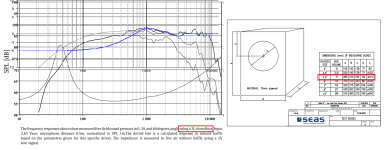Hi everybody!
I´m attaching a graph of the frequency response of the SEAS CA15RLY woofer under other graph produced by the Jeff Bagby's spreadsheet to evaluate the step that happen by the change from 4 pi to 2 pi radiation when mounted in a 7 L test box, as indicated in the woofer's specification sheet.
I hope overimposed graphs are not a mess, but clearly enough to see the similarity of both plots. Unfortunately, the frequency log scales aren't exactly the same in them.
At the right side of the graphs are the dimensions of the test boxes, also published by SEAS. I used those of the 7 L box for the calculation of the step in the Jeff's spreadsheet.
I would like to read your opinions. I think this is important when designing the crossover because the levels of the pass bands should be at the same height.
Cheers!
I´m attaching a graph of the frequency response of the SEAS CA15RLY woofer under other graph produced by the Jeff Bagby's spreadsheet to evaluate the step that happen by the change from 4 pi to 2 pi radiation when mounted in a 7 L test box, as indicated in the woofer's specification sheet.
I hope overimposed graphs are not a mess, but clearly enough to see the similarity of both plots. Unfortunately, the frequency log scales aren't exactly the same in them.
At the right side of the graphs are the dimensions of the test boxes, also published by SEAS. I used those of the 7 L box for the calculation of the step in the Jeff's spreadsheet.
I would like to read your opinions. I think this is important when designing the crossover because the levels of the pass bands should be at the same height.
Cheers!
Attachments
That’s a baffle step of nearly 8dB (blue line). Commonly 4π to 2π should be max 6dB.
But back to your question, SEAS datasheets do show the baffle step for the enclosures used. In theory you could correct for the calculated baffle step and correct again for the calculated baffle step of the enclosure you’ll be using.
But back to your question, SEAS datasheets do show the baffle step for the enclosures used. In theory you could correct for the calculated baffle step and correct again for the calculated baffle step of the enclosure you’ll be using.
